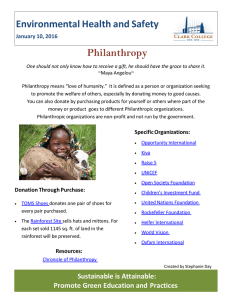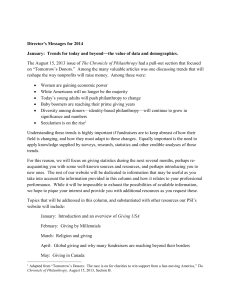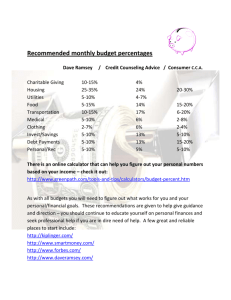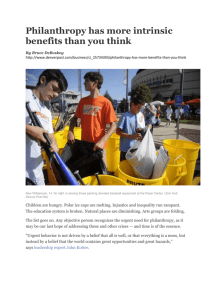Giving In Bear Times Intelligent Investing Panel Forbes.com - Magazine Article
advertisement
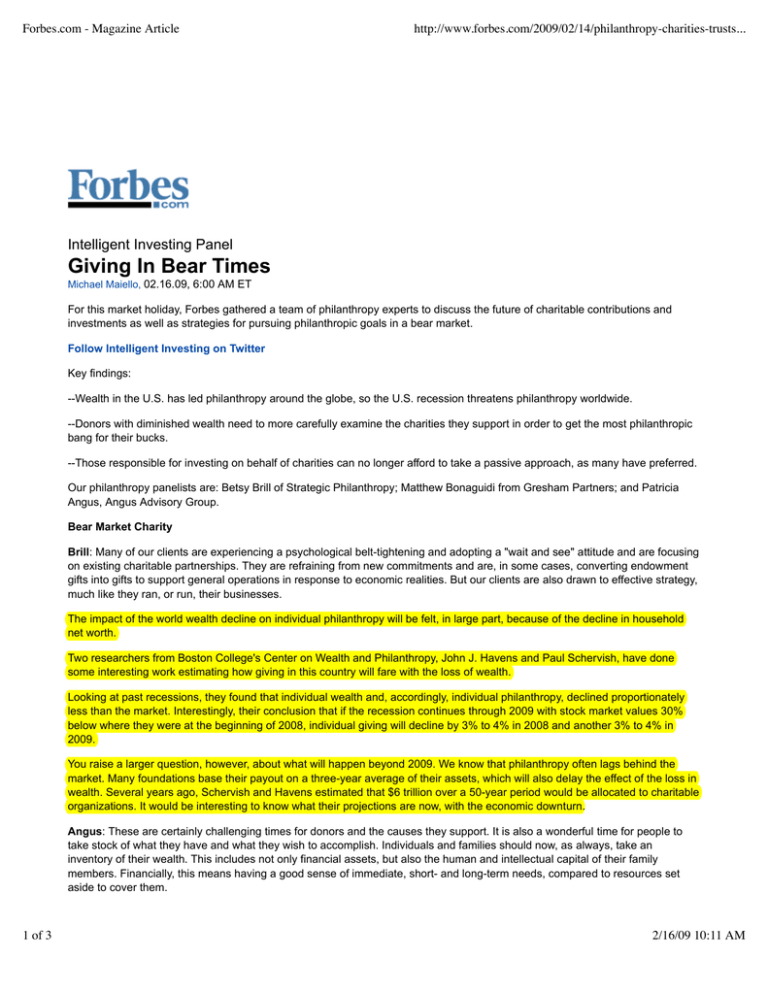
Forbes.com - Magazine Article http://www.forbes.com/2009/02/14/philanthropy-charities-trusts... Intelligent Investing Panel Giving In Bear Times Michael Maiello, 02.16.09, 6:00 AM ET For this market holiday, Forbes gathered a team of philanthropy experts to discuss the future of charitable contributions and investments as well as strategies for pursuing philanthropic goals in a bear market. Follow Intelligent Investing on Twitter Key findings: --Wealth in the U.S. has led philanthropy around the globe, so the U.S. recession threatens philanthropy worldwide. --Donors with diminished wealth need to more carefully examine the charities they support in order to get the most philanthropic bang for their bucks. --Those responsible for investing on behalf of charities can no longer afford to take a passive approach, as many have preferred. Our philanthropy panelists are: Betsy Brill of Strategic Philanthropy; Matthew Bonaguidi from Gresham Partners; and Patricia Angus, Angus Advisory Group. Bear Market Charity Brill: Many of our clients are experiencing a psychological belt-tightening and adopting a "wait and see" attitude and are focusing on existing charitable partnerships. They are refraining from new commitments and are, in some cases, converting endowment gifts into gifts to support general operations in response to economic realities. But our clients are also drawn to effective strategy, much like they ran, or run, their businesses. The impact of the world wealth decline on individual philanthropy will be felt, in large part, because of the decline in household net worth. Two researchers from Boston College's Center on Wealth and Philanthropy, John J. Havens and Paul Schervish, have done some interesting work estimating how giving in this country will fare with the loss of wealth. Looking at past recessions, they found that individual wealth and, accordingly, individual philanthropy, declined proportionately less than the market. Interestingly, their conclusion that if the recession continues through 2009 with stock market values 30% below where they were at the beginning of 2008, individual giving will decline by 3% to 4% in 2008 and another 3% to 4% in 2009. You raise a larger question, however, about what will happen beyond 2009. We know that philanthropy often lags behind the market. Many foundations base their payout on a three-year average of their assets, which will also delay the effect of the loss in wealth. Several years ago, Schervish and Havens estimated that $6 trillion over a 50-year period would be allocated to charitable organizations. It would be interesting to know what their projections are now, with the economic downturn. Angus: These are certainly challenging times for donors and the causes they support. It is also a wonderful time for people to take stock of what they have and what they wish to accomplish. Individuals and families should now, as always, take an inventory of their wealth. This includes not only financial assets, but also the human and intellectual capital of their family members. Financially, this means having a good sense of immediate, short- and long-term needs, compared to resources set aside to cover them. 1 of 3 2/16/09 10:11 AM Forbes.com - Magazine Article http://www.forbes.com/2009/02/14/philanthropy-charities-trusts... Families may find they have more funds available for giving than they expected. Beyond that, it involves assessing one's skills for earning, saving, investing and giving. On the giving front, it is now a good time to develop or refine one's mission (based on one's view of change and how to make it happen), but more important, it is a perfect time to dig deeper into learning about the needs of one's causes and the organizations working on them. This is a key time to make sure that giving is carefully aligned with needs and also to broaden giving beyond financial donations. The economic downturn will require donors and donees to work more efficiently together and seek leverage and collaboration more than before. These may be some of the silver linings of these challenging times. Bonaguidi: I agree with Betsy's thoughts on the need to become more strategic in your giving strategies in a bear market. Individuals and charitable organizations also have to be more strategic in the underlying investment strategies of charitable entities (foundations, donor-advised funds, charitable trusts, etc.) Far too many have taken a passive approach to their charitable investments and their charitable objectives. The investment makeup and due diligence of charitable assets for many were not aligned with charitable missions. Now, with asset values in many cases cut in half (or worse, if exposed to Madoff), individuals and organizations need to take a new look at their current investments and their charitable missions to efficiently and effectively accomplish their philanthropic goals. As advisers, we all need to push clients to avoid being a deer in the headlights. People are still in shock over the last six months. Many may think that simply waiting out the current environment will allow for a better outcome. However, the current environment is unlike any "bear market" experienced by the new wave of wealth. Individuals and charitable organizations will need to adjust to a new era of tactical planning. Brill: Matt and Patty--tactical, effective and strategic are definitely keywords for investors, whether they are looking at their financial or philanthropic investments. The current economic climate provides a unique opportunity for advisers to work more closely with their clients to ensure that their lifetime giving will have impact and be meaningful, and that their clients can secure a lasting legacy. There are opportunities to raise some very important questions about the kind of due diligence needed before making any charitable contributions. How much to give? What's the annual payout rate from a foundation or trust? Then there's the question of spending down vs. perpetuity and when and how to involve the next generation. In this changing landscape, addressing these questions will go a long way toward helping clients rethink and focus on priorities and opportunities. This is an opportunity for people to be more creative in their giving--exploring new strategies for supporting the causes they care about. Matt--can you clarify your question? Are you asking about resources coming into the U.S. or funds from the U.S. going outside the country? Bonaguidi: Percentage of U.S. vs. non-U.S. grant making, and the percent of U.S. vs. non-U.S. charitable assets. I do not have the statistics, but I would guess that as the historically richest economy, the U.S. is an important leader in private philanthropy. My speculation is that the historical reliance on the U.S. philanthropist as a percentage of overall giving will decline, with the current environment an inflection point for changing relative global wealth balances between countries (and their citizens). Angus: I am on the road right now and do not have access to the data, but I believe you are correct. The role (and financial magnitude) of private philanthropy has always been more important in the U.S. than in other countries, but this has been changing here and abroad for some time. The essential priorities and roles of government, the nonprofit (or independent) sector and business will now be in high relief. It will be more important than ever to look beyond mere financials when assessing the effectiveness of charitable organizations, especially those that are trying to solve issues that cannot be easily quantified. This will be true in the U.S. and abroad. Brill: I agree that donors will need to look at their charitable strategies and approaches differently over the next year, and probably well beyond. Getting more involved, more hands-on, as opposed to just being a financial supporter can serve to enhance their monetary gifts. This is an important consideration for all donors, especially at times when many are considering reducing their financial contributions. One technique that a number of our clients use is leveraging their social and professional knowledge, skills and relationships for 2 of 3 2/16/09 10:11 AM Forbes.com - Magazine Article http://www.forbes.com/2009/02/14/philanthropy-charities-trusts... the organizations they support. In some cases, they may consider giving of their own time and expertise as volunteers, or they may consider making in-kind donations. In fact, providing access to meeting facilities and information technology equipment and training are two of the most frequently requested types of assistance by grantee organizations. We encourage clients to listen to the organization to ensure that what they are offering truly meets its needs. On a related note, as Patty said, it is more important than ever to look beyond the financials when determining how and whether to continue supporting an organization. We advise clients to do some serious due diligence (particularly in light of the impact of Madoff on a myriad of organizations). We even put together the top 10 due diligence considerations for donors. Some of the tips on our "Top 10 To-Due Diligence List" for 2009 are: 1. Evaluate the mission, organizational focus and programs to determine if they are truly aligned with your philanthropic agenda. 2. Find out if, and how, the organization evaluates the impact and relevancy of its programs and services. 3. Check the status of the 501 (c)(3) designation and tax filings, and obtain a copy of any audit that has been done. 4. Be fully informed about the financial health of the organization. Review the organization's investment policy. Find out the track record of the investment manager(s). How diverse is the funding strategy and sources of funds? You don't want to be the primary donor, and you don't want your funds to go to organizations that can't survive or continue to be effective. 5. Inquire about whether or not there is a conflict of interest policy in place. Is the investment manager on the board of the organization (i.e., Bernard Madoff was on the board of Yeshiva University and "managed" their investments). 6. Review the program and services the organization provides. Are they aligned with the organization's mission, and is there the capacity to successfully deliver the programs and services? 7. Don't let emotions color your judgment or inhibit your due diligence. Understand that this a business/financial decision as well as a personal one. Virtually every non-profit is facing some degree of financial uncertainty. One area of uncertainty for all of them is to what degree they will continue to have the financial support they've enjoyed for years. Now more than ever, the partnership between donor and agency has to be as transparent as possible. Angus: Yes, this is the time to assess and implement "best practices"--it is the process, in the end, that will matter more than individual donations to ensure sustainability. Thanks for sharing your top ones, Betsy. I would also add that for many of my clients it is important to start their own journey (financial and philanthropic) with their own feelings about money, wealth and giving. Through this exploration, they are able to start from a place that feels more grounded that enhances their connection to their own wealth and increases their understanding of the challenges faced by the organizations they fund. Brill: On a final note, we believe that this is a time of great opportunity for strategic philanthropic investors. In stepping back and reflecting on current practice and refining focus and intent, those individuals (and their advisers) will be able to provide a more thoughtful and engaged approach to giving back and more creatively and successfully lay the groundwork for achieving real social impact. Three cheers to those advisers, of all disciplines, who see this as a real opportunity to effectively support their clients' philanthropic engagement during life and as a legacy for generations to come. Thank you all for your thoughtful participation. I look forward to continuing our dialogue next month. See More Intelligent Investing Features Next Panel, Feb. 17 at 6 a.m.: Retail Stocks 3 of 3 2/16/09 10:11 AM
